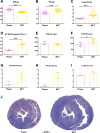Biventricular electromechanical dysfunction and molecular remodeling in a rat model of advanced pulmonary arterial hypertension
- PMID: 40652243
- PMCID: PMC12256005
- DOI: 10.1186/s12967-025-06792-w
Biventricular electromechanical dysfunction and molecular remodeling in a rat model of advanced pulmonary arterial hypertension
Abstract
Background: Pulmonary arterial hypertension (PAH) is a severe condition characterized by elevated pulmonary arterial pressure, leading to significant morbidity and mortality. Despite ongoing research, its pathophysiology remains incompletely understood. Traditionally, PAH has been regarded as predominantly affecting the right ventricle (RV), often overlooking its potential impact on the left ventricle (LV), particularly in patients with preserved LV ejection fraction (EF).
Methods: In this study, we investigate the late-stage effects of PAH on both electrical and mechanical functions, as well as their coupling, in each ventricle using the monocrotaline-treated rat model. Specifically, an integrative approach combining in-vivo epicardial potential mapping, in-situ video kinematic evaluation, and transcriptomic analysis was performed on rats injected with monocrotaline (MCT, n = 22) or saline solution (Physio, n = 16).
Results: Our findings reveal that PAH induces global increases in refractoriness from 88.8 ± 1.9 ms to 152.7 ± 3.9 ms and reductions in conduction velocity in the RV from 0.59 ± 0.01 m/s to 0.55 ± 0.01 m/s and from 0.28 ± 0.01 m/s to 0.25 ± 0.01 m/s along and across the fiber orientation, respectively. Notably, a significant increase in electromechanical delay from 24.9 ± 1.2 ms to 35.8 ± 5.2 ms was also observed in the RV. In the LV, PAH also results in increased refractoriness from 95.4 ± 3.0 ms to 140.0 ± 11.5 ms and reduced transverse conduction velocity by 14%, despite preserved EF. Transcriptomic analysis indicates that while both ventricles exhibit upregulation of extracellular matrix remodeling-related genes, the RV primarily shows downregulation of electromechanical-related genes. On the contrary, an upregulation of the inflammatory pathways was detected mainly in the LV, alongside a downregulation of mitochondrial metabolism-related genes.
Conclusions: Our findings revealed that both ventricles showed structural remodeling but only the RV underwent electromechanical alteration, while the LV displayed metabolic and inflammatory alteration. This was further validated by the preserved EF in the advanced stage of PAH. Our work highlights that a more comprehensive understanding of PAH pathophysiology can lead to targeted therapeutic strategies, challenging the conventional RV-centric perspective.
Keywords: Electromechanical coupling; Monocrotaline; Pulmonary hypertension; RNA sequencing; Refractoriness.
© 2025. The Author(s).
Conflict of interest statement
Declarations. Ethics approval and consent to participate: The study was performed following experimental protocols reviewed and approved by the Italian Ministry of Health (approved protocols: PMS53/2009, 281/2017, 989/2017, 397/2022-PR), under strict compliance with Italian (D.L.4/3/2014) and European (2010/63/UE) guidelines for ethical use of animal models in biological research. Consent for publication: Not applicable. Competing interests: GR and FPLM are the CEO and shareholder of the startup JEM Tech S.r.l., respectively.
Figures





References
-
- Guazzi M. Pulmonary hypertension in heart failure preserved ejection fraction: prevalence, pathophysiology, and clinical perspectives. Circ Heart Fail. 2014;7:367–77. - PubMed
-
- Kogler H, Hartmann O, Leineweber K, van Nguyen P, Schott P, Brodde OE, Hasenfuss G. Mechanical load-dependent regulation of gene expression in monocrotaline-induced right ventricular hypertrophy in the rat. Circ Res. 2003;93:230–7. - PubMed
-
- Hardziyenka M, Campian ME, de Bruin-Bon HA, Michel MC, Tan HL. Sequence of echocardiographic changes during development of right ventricular failure in rat. J Am Soc Echocardiogr. 2006;19:1272–9. - PubMed
MeSH terms
Substances
Grants and funding
- BANDO YIRG D.M. 737/2021/Ministero dell'Istruzione, dell'Università e della Ricerca
- MIUR/Ministero dell'Istruzione, dell'Università e della Ricerca
- 2018-2022/Ministero dell'Istruzione, dell'Università e della Ricerca
- MUR/Ministero dell'Istruzione, dell'Università e della Ricerca
- 2023-2027/Ministero dell'Istruzione, dell'Università e della Ricerca
- European Union-NextGenerationEU (Ecosister). Award Number: ECS00000033/Ministero dell'Istruzione, dell'Università e della Ricerca
- 202232A8AN/Ministero dell'Istruzione, dell'Università e della Ricerca
- P2022B38NR/Ministero dell'Istruzione, dell'Università e della Ricerca
- 202249XEA5/Ministero dell'Istruzione, dell'Università e della Ricerca
LinkOut - more resources
Full Text Sources

